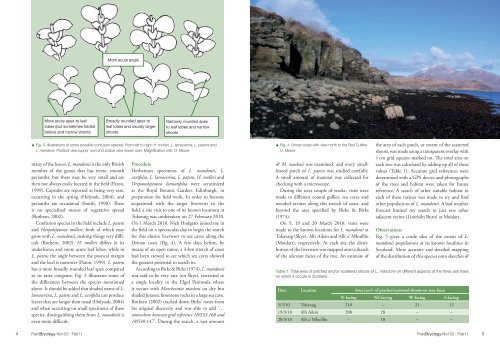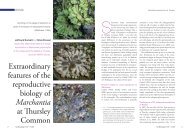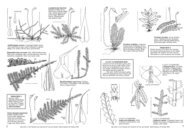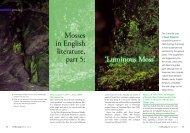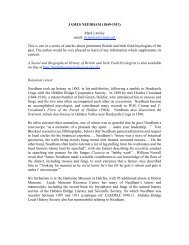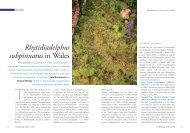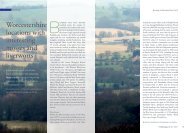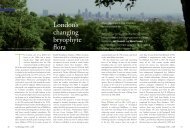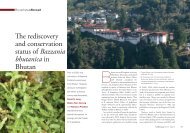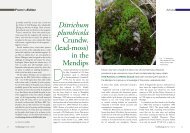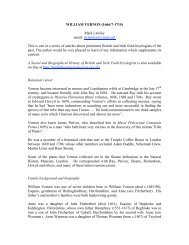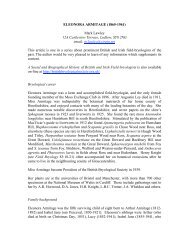Current status of the known populations of Lejeunea mandonii in ...
Current status of the known populations of Lejeunea mandonii in ...
Current status of the known populations of Lejeunea mandonii in ...
Create successful ePaper yourself
Turn your PDF publications into a flip-book with our unique Google optimized e-Paper software.
More acute apex to leaf<br />
lobes (but sometimes folded<br />
below) and narrow shoots<br />
More acute angle<br />
many <strong>of</strong> <strong>the</strong> leaves. L. <strong>mandonii</strong> is <strong>the</strong> only British<br />
member <strong>of</strong> <strong>the</strong> genus that has terete, smooth<br />
perianths, but <strong>the</strong>se may be very small and are<br />
<strong>the</strong>n not always easily located <strong>in</strong> <strong>the</strong> field (Paton,<br />
1999). Capsules are reported as be<strong>in</strong>g very rare,<br />
occurr<strong>in</strong>g <strong>in</strong> <strong>the</strong> spr<strong>in</strong>g (Holyoak, 2004), and<br />
perianths are occasional (Smith, 1990). There<br />
is no specialized means <strong>of</strong> vegetative spread<br />
(Ro<strong>the</strong>ro, 2002).<br />
Confusion species <strong>in</strong> <strong>the</strong> field <strong>in</strong>clude L. patens<br />
and Harpalejeunea molleri, both <strong>of</strong> which may<br />
grow with L. <strong>mandonii</strong>, mak<strong>in</strong>g th<strong>in</strong>gs very difficult<br />
(Ro<strong>the</strong>ro, 2002). H. molleri differs <strong>in</strong> its<br />
underleaves and more acute leaf lobes, while <strong>in</strong><br />
L. patens <strong>the</strong> angle between <strong>the</strong> postical marg<strong>in</strong><br />
and <strong>the</strong> keel is narrower (Paton, 1999). L. patens<br />
has a more broadly rounded leaf apex compared<br />
to its rarer congener. Fig. 3 illustrates some <strong>of</strong><br />
<strong>the</strong> differences between <strong>the</strong> species mentioned<br />
above. It should be added that shaded stems <strong>of</strong> L.<br />
lamacer<strong>in</strong>a, L. patens and L. cavifolia can produce<br />
leaves that are longer than usual (Holyoak, 2004)<br />
and when occurr<strong>in</strong>g on small specimens <strong>of</strong> <strong>the</strong>se<br />
species, dist<strong>in</strong>guish<strong>in</strong>g <strong>the</strong>m from L. <strong>mandonii</strong> is<br />
even more difficult.<br />
Broadly rounded apex to<br />
leaf lobes and usually larger<br />
shoots<br />
Narrowly rounded apex<br />
to leaf lobes and narrow<br />
shoots<br />
m Fig. 3. Illustrations <strong>of</strong> some possible confusion species. From left to right: H. molleri, L. lamacer<strong>in</strong>a, L. patens and<br />
L. <strong>mandonii</strong>. Postical view (upper row) and antical view (lower row). Magnification x40. O. Moore<br />
Procedure<br />
Herbarium specimens <strong>of</strong> L. <strong>mandonii</strong>, L.<br />
cavifolia, L. lamacer<strong>in</strong>a, L. patens, H. molleri and<br />
Drepanolejeunea hamatifolia were scrut<strong>in</strong>ized<br />
at <strong>the</strong> Royal Botanic Garden, Ed<strong>in</strong>burgh, <strong>in</strong><br />
preparation for field work. In order to become<br />
acqua<strong>in</strong>ted with <strong>the</strong> target liverwort <strong>in</strong> <strong>the</strong><br />
field, a site visit to one <strong>of</strong> its <strong>known</strong> locations at<br />
Tokavaig was undertaken on 27 February 2010.<br />
On 1 March 2010, Nick Hodgetts jo<strong>in</strong>ed me <strong>in</strong><br />
<strong>the</strong> field on a spectacular day to beg<strong>in</strong> <strong>the</strong> search<br />
for this elusive liverwort <strong>in</strong> sea caves along <strong>the</strong><br />
Dr<strong>in</strong>an coast (Fig. 4). A few days before, by<br />
means <strong>of</strong> an open canoe, a 3-km stretch <strong>of</strong> coast<br />
had been viewed to see which sea caves showed<br />
<strong>the</strong> greatest potential to search <strong>in</strong>.<br />
Accord<strong>in</strong>g to Birks & Birks (1974), L. <strong>mandonii</strong><br />
was said to be very rare (on Skye), restricted to<br />
a s<strong>in</strong>gle locality <strong>in</strong> <strong>the</strong> Elgol Pen<strong>in</strong>sula where<br />
it occurs with Marches<strong>in</strong>ia mackaii on dry but<br />
shaded Jurassic limestone rocks <strong>in</strong> a large sea cave.<br />
Ro<strong>the</strong>ro (2002) tracked down Birks’ notes from<br />
his orig<strong>in</strong>al discovery and was able to add ‘…<br />
somewhere between grid reference 18/553 160 and<br />
18/548 147’. Dur<strong>in</strong>g <strong>the</strong> search, a vast amount<br />
m Fig. 4. Dr<strong>in</strong>an coast with view north to <strong>the</strong> Red Cuill<strong>in</strong>s.<br />
O. Moore<br />
<strong>of</strong> M. mackaii was exam<strong>in</strong>ed, and every smallleaved<br />
patch <strong>of</strong> L. patens was studied carefully.<br />
A small amount <strong>of</strong> material was collected for<br />
check<strong>in</strong>g with a microscope.<br />
Dur<strong>in</strong>g <strong>the</strong> next couple <strong>of</strong> weeks, visits were<br />
made to different coastal gullies, sea caves and<br />
wooded rav<strong>in</strong>es along this stretch <strong>of</strong> coast, and<br />
beyond <strong>the</strong> area specified by Birks & Birks<br />
(1974).<br />
On 5, 19 and 20 March 2010, visits were<br />
made to <strong>the</strong> <strong>known</strong> locations for L. <strong>mandonii</strong> at<br />
Tokavaig (Skye), Allt Aile<strong>in</strong> and Allt a’ Mhuill<strong>in</strong><br />
(Moidart), respectively. At each site <strong>the</strong> distribution<br />
<strong>of</strong> <strong>the</strong> liverwort was mapped onto a sketch<br />
<strong>of</strong> <strong>the</strong> relevant facies <strong>of</strong> <strong>the</strong> tree. An estimate <strong>of</strong><br />
<strong>the</strong> area <strong>of</strong> each patch, or extent <strong>of</strong> <strong>the</strong> scattered<br />
shoots, was made us<strong>in</strong>g a transparent overlay with<br />
1 cm grid squares marked on. The total area on<br />
each tree was calculated by add<strong>in</strong>g up all <strong>of</strong> <strong>the</strong>se<br />
values (Table 1). Accurate grid references were<br />
determ<strong>in</strong>ed with a GPS device and photographs<br />
<strong>of</strong> <strong>the</strong> trees and habitat were taken for future<br />
reference. A search <strong>of</strong> o<strong>the</strong>r suitable habitat <strong>in</strong><br />
each <strong>of</strong> <strong>the</strong>se rav<strong>in</strong>es was made to try and f<strong>in</strong>d<br />
o<strong>the</strong>r <strong>populations</strong> <strong>of</strong> L. <strong>mandonii</strong>. A bad wea<strong>the</strong>r<br />
forecast limited my search to just one o<strong>the</strong>r<br />
adjacent rav<strong>in</strong>e (Limekiln Burn) at Moidart.<br />
Observations<br />
Fig. 5 gives a crude idea <strong>of</strong> <strong>the</strong> extent <strong>of</strong> L.<br />
<strong>mandonii</strong> <strong>populations</strong> at its <strong>known</strong> localities <strong>in</strong><br />
Scotland. More accurate and detailed mapp<strong>in</strong>g<br />
<strong>of</strong> <strong>the</strong> distribution <strong>of</strong> this species onto sketches <strong>of</strong><br />
Table 1. Total area <strong>of</strong> patches and/or scattered shoots <strong>of</strong> L. <strong>mandonii</strong> on different aspects <strong>of</strong> <strong>the</strong> three ash trees<br />
on which it occurs <strong>in</strong> Scotland<br />
Date Location Area (cm 2 ) <strong>of</strong> patches/scattered shoots on tree-faces<br />
N-fac<strong>in</strong>g NE-fac<strong>in</strong>g W-fac<strong>in</strong>g S-fac<strong>in</strong>g<br />
5/3/10 Tokavaig 210 – 21 12<br />
19/3/10 Allt Aile<strong>in</strong> 208 28 – –<br />
20/3/10 Allt a’ Mhuill<strong>in</strong> – 18 – –<br />
4 FieldBryology No103 | Feb11 FieldBryology No103 | Feb11 5


